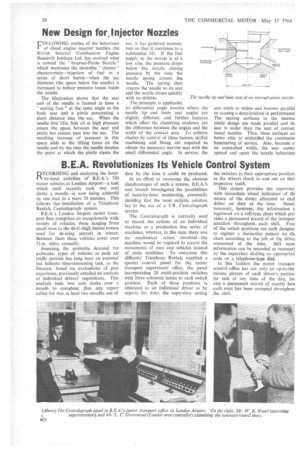B.E.A. Revolutionizes Its Vehicle Control System
Page 60

If you've noticed an error in this article please click here to report it so we can fix it.
D ECORDING and analysing the hour
by-hour activities of B.E.A.'s 750 motor vehicles at London Airport—a task which until recently took two cost clerks a month—is now being achieved by one man in a mere 50 minutes. This follows thew installation of a Telephone Rentals Centralograph system.
B.E.A.'s London Airport motor transport fleet comprises an exceptionally wide variety of vehicles, these ranging from small vans to the 40-ft.-high Simon towers used for de-icing aircraft in winter. Between them these vehicles cover over 54-,m. miles annually.
Assessing the probable demand for particular types of vehicles at peak air traffic periods has long been an essential but hitherto time-consuming task, as the forecast, based on evaluations of past experience, previously entailed an analysis of individual drivers' requisitions. This analysis took two cost clerks over a month to complete; thus any report called for was at least two months out of date by the time it could be produced.
In an effort to overcome the obvious disadvantages of such a system, B.E.A.'s cost branch investigated the possibilities of hour-by-hour monitoring, eventually deciding that the most suitable solution lay in the use of a T.R. Centralograph service.
The Centralograph is normally used to record the actions of an individual machine or a production line series of machines, whereas, in this case, there was no mechanical action involved—the machine would be required to record the movements of men and vehicles instead of static machines. To overcome this difficulty Telephone Rentals supplied a special control panel for the motor transport supervisors' office, the panel incorporating 20 multi-position switches with three coloured lamps to each switch position. Each of these positions is allocated to an individual driver as he reports for duty, the supervisor setting the switches to their appropriate position as the drivers check in and out on thei respective taskt
This system provides the superviso with immediate visual indication of thi nature of the duties allocated to eael driver on duty at the time. Simul taneously, however, this information i registered on a roll-type chart which pro vides a permanent record of the transpor situation throughout each shift Fow of the switch positions are each designec to register a distinctive pattern on thi chart according to the job of the drivel concerned at the time. Still mon information can be recorded as necessar3 by the supervisor dialling an appropriati code on a telephone-type dial.
In this fashion the motor transpor control office has not only an up-to-the, minute picture of each driver's partial, lar task at any time of the day, be also a permanent record of exactly hovi each man has been occupied throughow the shift.




































































































































